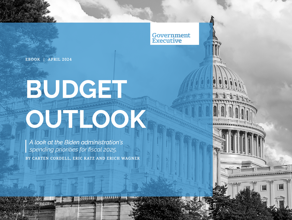Pentagon personnel reforms on the brink of completion
Labor relations rules scheduled to be in place in less than three months.
The Defense Department announced Friday that it is in the final stages of revising regulations for its new personnel system.
The proposed regulations creating the National Security Personnel System would replace the General Schedule system and implement a performance pay framework, streamline the employee appeals process and scale back collective bargaining. The system would affect about 700,000 employees.
The Pentagon has already passed the regulations on to the Office of Management and Budget to conduct an interagency review, NSPS spokeswoman Joyce Frank said. Initial revisions to the regulations were based on more than 58,000 comments received during the public comment period and input from unions during a "meet and confer" period, according to Frank.
The next steps are congressional notification and publication of the final regulations in the Federal Register, followed by a 30-day waiting period before the regulations can go into effect.
The group known as "Spiral One" that will be transitioned to the human resources portion of the system first will include up to 300,000 U.S.-based employees from Army, Navy, Marine Corps, and Air Force and Defense agencies. The group will be split into three sections; the first of which will begin training in late 2005 or early 2006. The two remaining portions of Spiral One will be transitioned in six-month increments.
Defense will implement the labor relations portion of the system before 2006. The proposed regulations would establish a National Security Labor Relations Board, with members appointed by the Defense secretary, to take the place of the Federal Labor Relations Authority in adjudicating personnel disputes. It would also expand the list of nonnegotiable subjects to include the "numbers, types, and grades of employees and the technology, methods, and means of performing work," among other changes.
American Federation of Government Employees officials said the union will almost certainly sue the department to halt the system upon publication of the final regulations. The union has already filed suit against the Pentagon over the process of proposing the new system, arguing the department did not properly confer with unions or follow the correct timeline, according to AFGE General Counsel Mark Roth. That case, which is before Clinton-appointed Judge Emmet Sullivan in the U.S. District Court for the District of Columbia, may be appended to include the labor relations regulations once they are published, Roth said.
AFGE, along with four other unions, has already had some success in the courts over issues of personnel reform. Judge Rosemary Collyer ruled in the same court that parts of the Homeland Security Department's similar personnel system were illegal, specifically, that regulations did not provide for adequate binding contracts.
NSPS officials said that court ruling does not directly affect their system.
"We're aware of the court case, obviously," Frank said. "We've made changes as a result of the comments we've received and our meetings with the unions anyway. Our statutes of authority are different than DHS."
Roth said the Pentagon's statute of authority is actually weaker than DHS' in terms of labor relations. He said the department only has authority to waive provisions of the existing federal labor relations laws in two situations: the creation of the NSLRB and the restriction of bargaining to national level unions.
In light of the DHS case, however, Roth said it is "hard to believe they wouldn't change those matters" that were ruled illegal. DHS is still deciding whether or not to appeal the decision.
The Pentagon published the first draft of its proposal in February. In July, 70,000 civilian defense employees completed a survey to identify performance factors that could be used to determine pay for workers under the system.


